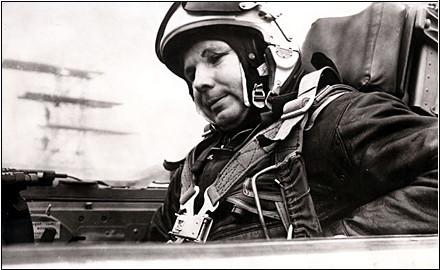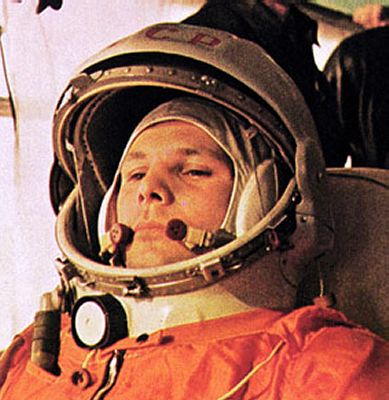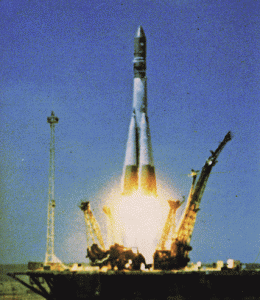
On 27 March 1968, the first son of humanity ever to break the bonds of Earth and venture into the ethereal blackness of space lost his life in a horrifying aircraft accident. Seven years earlier, Yuri Alexeyevich Gagarin had been literally transformed from a humble farmboy-turned-aviator into the most famous man in the world, when he circled the Home Planet once in his automatically-controlled Vostok 1 capsule. In a stroke, he cemented the credentials of Communist Russia, wreaked havoc in the political halls of the United States, and created a legend and a legacy which will endure so long as history continues to be written. Forty-five years ago tonight, the world mourned the loss of one of its finest sons … a son who grew up in the desperation of Nazi hegemony over his homeland, who reached the most exalted heights possible, and who died long before his time.
Like John Glenn—the first U.S. man in orbit—it seemed unlikely that Gagarin would ever be risked on another space mission; the importance of having him alive as an icon and a symbol of Soviet propaganda was simply too great. Still, in 1966, he trained as the backup pilot to Vladimir Komarov on the ill-fated Soyuz 1 and may have been pointed toward a subsequent mission. This became increasingly untenable in the wake of Komarov’s tragic death during his descent to Earth, but Gagarin nevertheless defended his Candidate of Technical Sciences thesis at the Zhukovsky Air Force Academy and maintained some hope. On 27 March 1968, joined by instructor pilot Vladimir Seregin, he took off from the Chkalovskaya airfield, near Moscow, in an antiquated MiG-15UTI trainer aircraft. Shortly afterwards, Gagarin requested permission to alter his course.

Then, at 10:31 a.m. Moscow Time, all communications with the men were lost.
“The weather was very bad that day,” remembered fellow cosmonaut Alexei Leonov in his memoir, Two Sides of the Moon. At the time, Leonov was overseeing parachute jumps from a helicopter near Kirzach airfield. “The cloud cover was low and it was raining hard. My team had performed just one jump when the weather deteriorated even further. The rain turned to sleet and conditions were so bad that I canceled the session and requested permission to return to base.” As he waited to learn if his request had been granted, Leonov heard two loud bangs from the distance—one of them clearly an explosion, the other a sonic boom—with barely a second or so between them. During the return to base, he was puzzled when the control tower kept radioing Gagarin’s callsign. Leonov wondered if they were mistakenly calling him instead, but upon landing he was told that contact had been lost with Gagarin and Seregin. When Leonov described the explosions he had heard, a helicopter was hastily despatched to the last known location of Gagarin.
At length, as the late afternoon dimness gave way to a wintry twilight, the helicopter commander reported finding the wreckage of the MiG some 64 km from the airfield. Debris was scattered in a wooded area and the aircraft’s engine was buried several metres underground. Search and rescue forces, who arrived shortly thereafter, determined that the MiG-15 had hit the ground at over 700 km/h.
An upper jaw, identified as that of Seregin, was found, but as yet they had no confirmatory evidence that Gagarin had also died. Early the following morning, a piece of cloth hanging from a birch tree offered the first proof: it was from Gagarin’s flight jacket. Clearly, neither he nor Seregin had ejected. The men’s remains—described as “fingers, toes, pieces of ribcage, and skull” by Jamie Doran and Piers Bizony in Starman, their biography of Gagarin—were both interred in the Kremlin Wall. The cause of the accident was hard to find. Theories included a birdstrike, a collision with a hot-air balloon (the remains of which were found close to the crash site), and even more outlandish notions that Gagarin was drunk or Seregin was taking pot-shots at wild deer from the MiG. Still others postulated that after angrily throwing a cognac in General Secretary Leonid Brezhnev’s face in the wake of Komarov’s death, Gagarin had been imprisoned or confined to a mental asylum. …

In December 1968, the official accident report pointed toward pilot error, but when the classified files were reopened two decades later it became more likely that Gagarin and Seregin did not have accurate altitude data and had flown into an area where a supersonic Sukhoi Su-15 jet was operating. Bizony and Doran noted that Seregin was told the cloud base was 10,000 meters, when in fact it was nearer to 450 meters. Witnesses would later confirm seeing both Gagarin’s aircraft and the Su-15. “According to the flight schedule of that day,” wrote Leonov, “the Sukhoi was prohibited from flying lower than 10,000 meters. I believe now, and believed at the time, that the accident happened when the jet pilot violated the rules and dipped below the cloud cover for orientation … that he passed within 10 or 20 meters of Yuri and Seregin’s plane while breaking the sound barrier. The air turbulence overturned their jet and sent it into a fatal flat spin.” In such a situation, and thinking they were higher than they actually were, Seregin and Gagarin would have had no time to eject.
It was Leonov who finally identified Gagarin’s physical remains … from fragments of flesh removed from the crash site and placed into a metallic bowl. “A few days before,” he wrote, “I had accompanied Yuri to the barber to have his hair cut. I had stood behind Yuri talking while the barber worked. When he came to trim the hairs at the base of Yuri’s neck, he noticed a large, dark brown mole.” Leonov joked that the barber should be careful not to cut the mole, little realising that it would prove pivotal shortly thereafter in identifying the last mortal remains of Yuri Alexeyevich Gagarin.
“Looking down at the fragments of flesh lying in that metal bowl,” Leonov wrote, “I saw that one bore the mole.” It was comprehensive proof that the man who had achieved so much in his short life had ended his days, ignominiously, in an accident which might easily have been avoided. One of the lasting tragedies is that this promising young man was torn from humanity, in his prime, and at a time when he had so much more to offer us. Gagarin’s youth belied a keen engineering and piloting mind and an intellect beyond his peasant-stock roots. His first words upon launching from Baikonur on 12 April 1961 were words of adrenaline-driven excitement, but were also enormously reflective of the road into space upon which humanity had set its feet. They were also illustrative of the challenges which lay ahead, and which today’s astronauts and cosmonauts continue to face, but were tinged with a childlike desire to push the envelope further than it had even been pushed before.
“Poyekhali!”
“Let’s go!”
Godspeed, Yuri Gagarin.




Great tribute to Yuri Gagarin. He remains an icon in the annals of manned spaceflight. He nearly lost his life on re-entry when his spherical cabin did not immediately separate from the “service module.” It was only when the straps burned through that the cabin was able to perform a safe re-entry. He remains the astronaut who spent the LEAST time in space – 108 minutes.
Great article! There are unconfirmed rumors that Komorov knew about the deficiencies in Soyuz 1 but choose to fly the mission anyway to save Yuri Gagarin’s life who was also his friend. This would make the anger of Gagarin towards Brezhnev, who pushed for the mission, very understandable. I can’t imagine the guilt he must have felt…
Vlad: I’ve read those same rumors about Komarov insisting to fly instead of Gagarin. Gagarin was assigned as “back up” to Komarov (or so it is believed). Although Soyuz 1 flew 25 months after Leonov’s Voshkod 2 spacewalk mission, the Soyuz was a flawed craft, with fewer test flights prior to being manned-rated. That was atypical for the Russians. It is suspected that the snarled parachute was a result of a poorly-designed canister that was also packed too tightly. The same was true for Soyuz 2 (Bykovsky, Yeliseyev and Khrunov). Had Soyuz 2 been launched, that crew might have suffered the same parachute malfunction. Chilling, to say the least!
Tom and Vlad, a few months ago Ben Evans wrote an excellent article (no surprise there) about Komarov insisting upon taking the place of Gagarin on Soyuz 1, or as Komarov called it “That Devil Ship” because Gagarin was too valuable to be lost should the craft malfunction. It is a very well-written in-depth article, and hopefully it has been archived by AmericaSpace.
In the picture of Gagarin riding the bus to the launch site, the photo is cropped and does not show the face of cosmonaut Grigori Nelyubov who was among the top pilot-cosmonauts and might have been among the first to fly in space. A later incident caused him to be dismissed from the cosmonaut group (and subsequently air-brushed out of photos). He was killed in a train accident when he reportedly slipped and fell onto the coming train while in a drunken stupor. Gherman
Titov was suited up and ready to go in case there was a problem with Gagarin.
Karol, there’s a link to my Komarov article embedded within the Gagarin article. Thanks for your kind comments guys.
Ben: Your article on the Komarov crash is, in my estimation, the definitive work on the subject. I totally reject the comments made by others regarding the “sources” as well as the photo of Komarov’s remains. (Note: Cosmonaut Pavel Popovich is directly above the “head” portion of the remains – I’m not sure who the others are). Chertok’s “Rockets and People” is also an excellent source on the subject, but you have written the most accurate, comprehensive summary of this unfortunate chapter in manned spaceflight!
Excellent post Tom! I couldn’t agree more. Wouldn’t it be great if all of the articles written by Ben were on CD and available for purchase as a set? Please put my name on the waiting list! 🙂